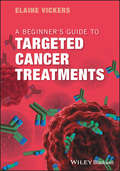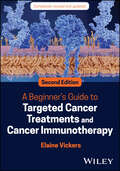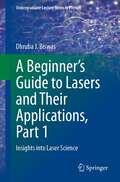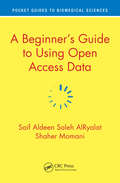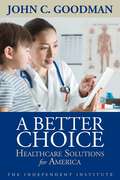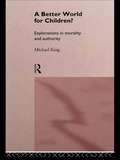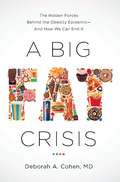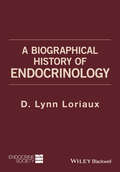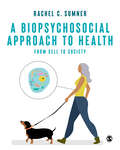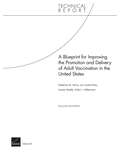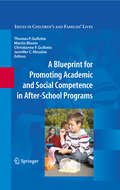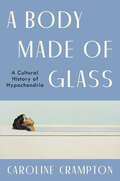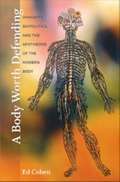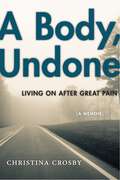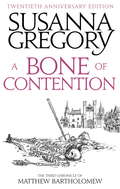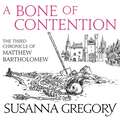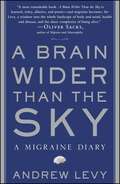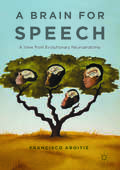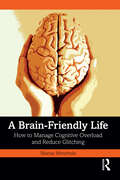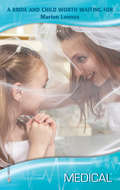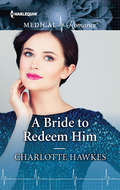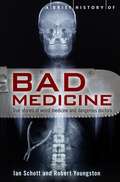- Table View
- List View
A Beginner's Guide to Targeted Cancer Treatments
by Elaine VickersThe accessible guide to the principles behind new, more targeted drug treatments for cancer Written for anyone who encounters cancer patients, cancer data or cancer terminology, but have no more than a passing knowledge of cell biology. A Beginner's Guide to Targeted Cancer Treatments provides an understanding of how cancer works and the many new treatments available. Using over 100 original illustrations, this accessible handbook covers the biology and mechanisms behind a huge range of targeted drug treatments, including many new immunotherapies. Dr Vickers translates a complex and often overwhelming topic into something digestible and easily understood. She also explains what cancer is, how it behaves and how our understanding of cancer has changed in recent years. Each chapter takes the reader through how new cancer drugs work and their benefits and limitations. With the help of this book, readers will be able to better understand more complex, in-depth articles in journals and books and develop their knowledge. This vital resource: Offers the latest insights into cancer biology Provides a broad understanding of how targeted cancer treatments work Describes many of the new immunotherapy approaches to cancer treatment, such as checkpoint inhibitors and CAR-modified T cells Helps readers feel confident discussing treatment options with colleagues and patients Provides an overview of which treatments are relevant to each of the most common solid tumours and haematological cancers, and the rationale behind them Demystifies the jargon – terms such as the EMT, cancer stem cells, monoclonal antibodies, kinase inhibitors, angiogenesis inhibitors etc. Explains the resistance mechanisms to many new treatments, including issues such as the way cancer cells diversify and evolve and the complex environment in which they live
A Beginner's Guide to Targeted Cancer Treatments and Cancer Immunotherapy
by Elaine VickersDemystifying the science behind new cancer treatments A clear and accessible guide written in everyday language for nurses and other healthcare professionals A Beginner’s Guide to Targeted Cancer Treatments and Cancer Immunotherapy helps readers understand the science behind many of the newer drug treatments for cancer. Assuming only a basic familiarity with cell biology, this easy-to-digest guide describes how our increased understanding of cancer has been translated into the creation of new cancer treatments with a wide range of targets. Gifted communicator and educator Dr. Elaine Vickers helps you understand the mechanisms of a wide range of individual targeted therapies and immunotherapies — enabling you to communicate effectively with your colleagues and patients. Concise chapters explain how new cancer drugs and immunotherapies work, discuss their benefits, identify their limitations, and more. Now in its second edition, this popular handbook is fully revised to reflect the latest developments in targeted drug therapies and immunotherapies. Entirely new chapters on advancements in various immunotherapies are accompanied by more than 100 new and updated color illustrations. Provides an up-to-date overview of relevant treatment targets for all major cancer types, including hematological cancersDescribes cancer biology and the relationship between cancer and the immune systemOffers valuable insights into cell communication pathways as a common targetCovers small molecule drugs, antibody-based treatments, and cellular therapies, including novel immunotherapies A Beginner’s Guide to Targeted Cancer Treatments and Cancer Immunotherapy is a must-have resource for trainees, practicing nurses, and other healthcare professionals involved in the care of cancer patients, as well as non-specialists who encounter cancer data or cancer terminology in their field.
A Beginner’s Guide to Lasers and Their Applications, Part 1: Insights into Laser Science (Undergraduate Lecture Notes in Physics)
by Dhruba J. BiswasThis two-volume book provides an enriching insight into the laser, covering different types of lasers, the basic science behind the technology, their role at the cutting-edge of current scientific research, and their wide-ranging applications. With just high school physics as a prerequisite and favoring qualitative yet scientifically sound explanations over high-level mathematics, this book is aimed at a broad spectrum of readers in physics, chemistry, engineering, medicine, and biology. Its engaging and lucid presentation is enhanced with plenty of illustrations, making the world of the laser accessible to undergraduate students in the sciences and any other inquisitive readers with high school physics under their belts. Furthermore, the text is often laced with anecdotes, picked from history, that are bound to pique the minds of the readers. It is ideal for self-study or as a complement to courses on optics and optoelectronics. This volume, Part 1 of 2, explains the fundamentals of optics, what a laser is, how it works, and what is unique about the light it emits, from fundamental quantum theory through population inversion and cavity to common laser types. It is followed by Part 2 which depicts the many advances in science enabled by the laser, including spectroscopy, nonlinear optics, optical cooling and trapping, and optical tweezers, among many others, and provides a glimpse into the ways that the laser affects our lives via its uses in medicine, manufacturing, the nuclear industry, energy, defence, communication, ranging, pollution monitoring, art conservation, fashion, beauty, and entertainment.
A Beginner’s Guide to Using Open Access Data (Pocket Guides to Biomedical Sciences)
by Saif Aldeen AlRyalat Shaher MomaniOpen Access Data is emerging as a source for cutting edge scholarship. This concise book provides guidance from generating a research idea to publishing results. Both young researchers and well-established scholars can use this book to upgrade their skills with respect to emerging data sources, analysis, and even post-publishing promotion. At the end of each chapter, a tutorial simulates a real example, allowing readers to apply what they learned about accessing open data, and analyzing this data to reach the results. This book can be of use by established researchers analyzing data, publishing, and actively promoting ongoing and research. Key selling features: Describes the steps, from A-Z, for doing open data research Includes interactive tutorials following each chapter Provides guidelines for readers so that they can use their own accessed open data Reviews recent software and websites promoting and enabling open data research Supplements websites which update recent open data sources
A Better Choice: Healthcare Solutions for America
by John C. GoodmanThe Patient Protection and Affordable Care Act—a.k.a. Obamacare—remains highly controversial and faces ongoing legal and political challenges. Polls show that by a large margin Americans remain opposed to the healthcare law and seek to &“repeal and replace&” it. However, the question is: Replace it with what?In A Better Choice, John C. Goodman clearly and concisely provides the compelling answer—no small feat, considering the complexity and intransigence of problems that have long plagued American healthcare. His prescription of four key reforms may garner the greatest attention as policymakers and the public search for a way out of the healthcare quagmire. For anyone who wants to learn about some of the boldest prescriptions designed to remedy our healthcare system, Goodman&’s book is a must-read.
A Better World for Children?: Explorations in Morality and Authority
by Michael KingBy exploring such diverse issues as the management of child abuse, legal reforms following sex abuse enquiries, moral explanations for the actions of child murderers, the impossible task faced by social workers and the limitations of children's rights campaigns, Michael King examines the revolutionary ideas of the social theorist, Niklas Luhmann. He demonstrates how Luhmann's theory of authopoietic systems compels readers to re-examine exactly what they mean by society. Questioning the relationship between personal morality and political will, it challenges the assumption that changing society is merely a matter of changing attitudes and highlights the pitfalls associated with formulating social reform.
A Big Fat Crisis: The Hidden Forces Behind the Obesity Epidemic - and How We Can End It
by Deborah A. CohenObesity is the public health crisis of the twenty-first century. Over 150 million Americans are overweight or obese, and across the globe an estimated 1. 5 billion are affected. In A Big Fat Crisis, Dr. Deborah A. Cohen has created a major new work that will transform the conversation surrounding the modern weight crisis. Based on her own extensive research, as well as the latest insights from behavioral economics and cognitive science, Cohen reveals what drives the obesity epidemic and how we, as a nation, can overcome it. Cohen argues that the massive increase in obesity is the product of two forces. One is the immutable aspect of human nature, namely the fundamental limits of self-control and the unconscious ways we are hard-wired to eat. And second is the completely transformed modern food environment, including lower prices, larger portion sizes, and the outsized influence of food advertising. We live in a food swamp, where food is cheap, ubiquitous, and insidiously marketed. This, rather than the much-discussed "food deserts,” is the source of the epidemic. The conventional wisdom is that overeating is the expression of individual weakness and a lack of self-control. But that would mean that people in this country had more willpower thirty years ago, when the rate of obesity was half of what it is today! The truth is that our capacity for self-control has not shrunk; instead, the changing conditions of our modern world have pushed our limits to such an extent that more and more of us are simply no longer up to the challenge. Ending this public health crisis will require solutions that transcend the advice found in diet books. Simply urging people to eat less sugar, salt, and fat has not worked. A Big Fat Crisis offers concrete recommendations and sweeping policy changes-including implementing smart and effective regulations and constructing a more balanced food environment-that represent nothing less than a blueprint for defeating the obesity epidemic once and for all
A Biographical History of Endocrinology
by D. Lynn LoriauxEstablishing endocrinology as a distinct medical specialty was no easy task. This engaging volume chronicles the journey through the stories of the men ?and occasional women?who shaped the specialty through the ages. In 108 brief chapters, A Biographical History of Endocrinology illuminates the progress of endocrinology from Hippocrates to the modern day. The author highlights important leaders and their contributions to the field, including these early pioneers: Kos and Alexandria, and the first human anatomy Bartolomeo Eustachi and the adrenal gland Richard Lower and the pituitary gland Thomas Addison and adrenal insufficiency Franz Leydig and testosterone secreting cells Wiliam Stewart Halsted and surgery of the thyroid gland John J. Abel and isolation of hormones Hakaru Hashimoto and his disease Covering all the watershed moments in the history of the profession, the book identifies key figures whose contributions remain relevant today. Their fascinating stories of experiments and studies, advocacy and adversity, and exploring unknown territory will inspire the next generation of endocrinologists and satisfy every clinician who ever wondered ?how did we get here?? This comprehensive yet concise biographical history of endocrinology will benefit not only practicing and prospective endocrinologists, but also other medical specialists and medical historians.
A Biopsychosocial Approach to Health: From Cell to Society
by Rachel C. SumnerThis unique text takes a holistic approach to show you how different biological and medical aspects of health operate at the cellular level all the way up to the societal level, and back again. It explains key biological aspects of health at the cellular level (such as epigenetics and oxidative stress) to give you a solid understanding of how health is created in the context of the person, before working upwards to examine public health issues ranging from cardiovascular disease to unemployment and loneliness. Throughout the text, you will encounter a diverse range of cross-cultural examples, real-world scenarios and key questions which will help you put the theories and cell-to-society perspective you have learned into practice. With interdisciplinary perspectives from psychoneuroimmunology and epidemiology, this book offers an integrated consideration of health and its biopsychosocial determinants. It is a must-read for students of health psychology, applied psychology, nursing, and public health. Rachel C. Sumner is a psychobiologist and chartered psychologist with the British Psychological Society Division of Health Psychology and a senior research fellow at Cardiff Metropolitan University.
A Biopsychosocial Approach to Health: From Cell to Society
by Rachel C. SumnerThis unique text takes a holistic approach to show you how different biological and medical aspects of health operate at the cellular level all the way up to the societal level, and back again. It explains key biological aspects of health at the cellular level (such as epigenetics and oxidative stress) to give you a solid understanding of how health is created in the context of the person, before working upwards to examine public health issues ranging from cardiovascular disease to unemployment and loneliness. Throughout the text, you will encounter a diverse range of cross-cultural examples, real-world scenarios and key questions which will help you put the theories and cell-to-society perspective you have learned into practice. With interdisciplinary perspectives from psychoneuroimmunology and epidemiology, this book offers an integrated consideration of health and its biopsychosocial determinants. It is a must-read for students of health psychology, applied psychology, nursing, and public health. Rachel C. Sumner is a psychobiologist and chartered psychologist with the British Psychological Society Division of Health Psychology and a senior research fellow at Cardiff Metropolitan University.
A Biostatistics Toolbox for Data Analysis
by Steve SelvinThis sophisticated package of statistical methods is for advanced master's (MPH) and PhD students in public health and epidemiology who are involved in the analysis of data. It makes the link from statistical theory to data analysis, focusing on the methods and data types most common in public health and related fields. Like most toolboxes, the statistical tools in this book are organized into sections with similar objectives. Unlike most toolboxes, however, these tools are accompanied by complete instructions, explanations, detailed examples, and advice on relevant issues and potential pitfalls - conveying skills, intuition, and experience. The only prerequisite is a first-year statistics course and familiarity with a computing package such as R, Stata, SPSS, or SAS. Though the book is not tied to a particular computing language, its figures and analyses were all created using R. Relevant R code, data sets, and links to public data sets are available from www. cambridge. org/9781107113084.
A Blueprint for Improving the Promotion and Delivery of Adult Vaccination in the United States
by Lori Uscher-Pines Soeren Mattke Katherine M. Harris Arthur L. KellermannVaccine-preventable disease continues to take a heavy toll on adults despite the widespread availability of effective vaccines. This report identifies where efforts to improve the delivery of adult vaccination have stalled and recommends targeted strategies that are supported by available evidence and build on existing infrastructure.
A Blueprint for Promoting Academic and Social Competence in After-School Programs (Issues in Children's and Families' Lives #10)
by Thomas P. Gullotta Martin Bloom Jennifer C. Messina Christianne F. GullottaSchool activities alone are not always sufficient to ensure children's academic progress or socio-emotional development and well-being. And the time when many children typically have the least adult supervision - immediately after school - is also the time that they are at the highest risk to act as perpetrators or become victims of antisocial behavior. Throughout A Blueprint for Promoting Academic and Social Competence in After-School Programs, which focuses on children in grades 1 through 6, noted experts identify the best practices of effective programs and pinpoint methods for enhancing school-based skills and making them portable to home and neighborhood settings. This volume: (1) Analyzes the concepts central to effective after-school programs. (2) Offers developmental, cognitive, and social ecology perspectives on how children learn. (3) Features more than 100 exercises that develop young people's capabilities for academic, social, moral, and emotional learning - These exercises are ready to use or can be adapted to students' unique needs. (4) Emphasizes young people's development as students and as productive members of society during middle to late childhood and early adolescence. (5) Presents explicit theory and evidence that can be used to explain the value of after-school programs for budget proposals. This important book will find an appreciative, ready audience among the program directors who design after-school curricula, the educators who implement them, the mental health and social work professionals who help staff them, and the current crop of graduate students who will create the next generation of programs.
A Body Made of Glass: A Cultural History of Hypochondria
by Caroline CramptonPart cultural history, part literary criticism, and part memoir, A Body Made of Glass is a definitive biography of hypochondria.Caroline Crampton’s life was upended at the age of seventeen, when she was diagnosed with Hodgkin’s lymphoma, a relatively rare blood cancer. After years of invasive treatment, she was finally given the all clear. But being cured of the cancer didn’t mean she felt well. Instead, the fear lingered, and she found herself always on the alert, braced for signs that the illness had reemerged. Now, in A Body Made of Glass, Crampton has drawn from her own experiences with health anxiety to write a revelatory exploration of hypochondria—a condition that, though often suffered silently, is widespread and rising. She deftly weaves together history, memoir, and literary criticism to make sense of this invisible and underexplored sickness. From the earliest medical case of Hippocrates to the literary accounts of sufferers like Virginia Woolf and Marcel Proust to the modern perils of internet self-diagnosis, Crampton unspools this topic to reveal the far-reaching impact of health anxiety on our physical, mental, and emotional health.At its heart, Crampton explains, hypochondria is a yearning for knowledge. It is a never-ending attempt to replace the edgeless terror of uncertainty with the comforting solidity of a definitive explanation. Through intimate personal stories and compelling cultural perspectives, A Body Made of Glass brings this uniquely ephemeral condition into much-needed focus for the first time.
A Body Worth Defending: Immunity, Biopolitics, and the Apotheosis of the Modern Body
by Ed CohenBiological immunity as we know it does not exist until the late nineteenth century. Nor does the premise that organisms defend themselves at the cellular or molecular levels. For nearly two thousand years "immunity," a legal concept invented in ancient Rome, serves almost exclusively political and juridical ends. "Self-defense" also originates in a juridico-political context; it emerges in the mid-seventeenth century, during the English Civil War, when Thomas Hobbes defines it as the first "natural right. " In the 1880s and 1890s, biomedicine fuses these two political precepts into one, creating a new vital function, "immunity-as-defense. " In A Body Worth Defending, Ed Cohen reveals the unacknowledged political, economic, and philosophical assumptions about the human body that biomedicine incorporates when it recruits immunity to safeguard the vulnerable living organism. Inspired by Michel Foucault's writings about biopolitics and biopower, Cohen traces the migration of immunity from politics and law into the domains of medicine and science. Offering a genealogy of the concept, he illuminates a complex of thinking about modern bodies that percolates through European political, legal, philosophical, economic, governmental, scientific, and medical discourses from the mid-seventeenth century through the twentieth. He shows that by the late nineteenth century, "the body" literally incarnates modern notions of personhood. In this lively cultural rumination, Cohen argues that by embracing the idea of immunity-as-defense so exclusively, biomedicine naturalizes the individual as the privileged focus for identifying and treating illness, thereby devaluing or obscuring approaches to healing situated within communities or collectives.
A Body, Undone: Living On After Great Pain (Political Economy of the Austrian #8)
by Christina CrosbyA &“transformative&” memoir &“about a calamitous accident. . . . also about the accident of all our lives, and the . . . mortality that informs every one of our days&” (Los Angeles Review of Books). In the early evening on October 1, 2003, Christina Crosby was three miles into a seventeen mile bicycle ride, intent on reaching her goal of one thousand miles for the riding season. She was a respected senior professor of English who had celebrated her fiftieth birthday a month before. As she crested a hill, she caught a branch in the spokes of her bicycle, which instantly pitched her to the pavement. Her chin took the full force of the blow, and her head snapped back. In that instant, she was paralyzed. In A Body, Undone, Crosby writes about a body shot through with neurological pain, disoriented in time and space, incapacitated by paralysis and deadened sensation. To address this foreign body, she calls upon the readerly pleasures of narrative, critical feminist and queer thinking, and the concentrated language of lyric poetry. She recalls her 1950s tomboy ways in small-town, rural Pennsylvania, and growing up during the 1970s through radical feminism and the affirmations of gay liberation. Deeply unsentimental, A Body, Undone is a compelling account of living on, as Crosby rebuilds her body and fashions a life through writing, memory, and desire. &“An extraordinary and luminous book.&” —Judith Butler, author of Precarious Life &“Tender, fierce, and eloquent.&” —Laura S. Levitt, author of American Jewish Loss after the Holocaust &“[Crosby] asks readers to recognize how messy, precarious, and queer, in every sense of the word, life in a body can be.&” —The NewYorker.com &“Elegant and harrowing.&” —The Washington Post
A Bone Of Contention: The third Matthew Bartholomew Chronicle (Chronicles Of Matthew Bartholomew Ser. #3)
by Susanna GregoryFor the twentieth anniversary of the Matthew Bartholomew series, Sphere reissued the books with beautiful new illustrated covers.-----------------------------Cambridge in 1352 is rife with terrible clashes between the fledgling University and the townspeople. Matthew Bartholomew, physician and teacher at Michaelhouse college, is trying to keep the peace when a student is murdered and the town plunges into chaos. At the same time a skeleton is discovered that is rumoured to belong to a local martyr, and Bartholomew has his hands full investigating both deaths while the rioting intensifies...
A Bone Of Contention: The third Matthew Bartholomew Chronicle (Chronicles of Matthew Bartholomew #3)
by Susanna GregoryFor the twentieth anniversary of the Matthew Bartholomew series, Sphere reissued the books with beautiful new illustrated covers.-----------------------------Cambridge in 1352 is rife with terrible clashes between the fledgling University and the townspeople. Matthew Bartholomew, physician and teacher at Michaelhouse college, is trying to keep the peace when a student is murdered and the town plunges into chaos. At the same time a skeleton is discovered that is rumoured to belong to a local martyr, and Bartholomew has his hands full investigating both deaths while the rioting intensifies...
A Bone Of Contention: The third Matthew Bartholomew Chronicle (Chronicles of Matthew Bartholomew #3)
by Susanna GregoryFor the twentieth anniversary of the Matthew Bartholomew series, Sphere reissued the books with beautiful new illustrated covers.-----------------------------Cambridge in 1352 is rife with terrible clashes between the fledgling University and the townspeople. Matthew Bartholomew, physician and teacher at Michaelhouse college, is trying to keep the peace when a student is murdered and the town plunges into chaos. At the same time a skeleton is discovered that is rumoured to belong to a local martyr, and Bartholomew has his hands full investigating both deaths while the rioting intensifies...
A Brain Wider Than the Sky: A Migraine Diary
by Andrew LevyWith more than one in ten Americans--and more than one in five families--affected, the phenomenon of migraine is widely prevalent yet often ignored or misdiagnosed. For Andrew Levy, his migraines were occasional reminders of a persistent illness that he'd wrestled with half his life. Then in 2006 Levy was struck almost daily by a series of debilitating migraines that kept him essentially bedridden for months, imprisoned by pain and nausea that retreated only briefly in gentler afternoon light. When possible, he kept careful track of what triggered an onset and in luminous prose recounts his struggle to live with migraines, his meticulous attempts at calibrating his lifestyle to combat and avoid them, and most tellingly, the personal relationship a migraineur develops--an almost Stockholm syndrome-like attachment--with the indescribable pain, delirium, and hallucinations. Levy researched how personalities and artists throughout history--Alexander Pope, Freud, Virginia Woolf, even Elvis--dealt with their migraines and candidly describes his rehabilitation with the aid of prescription drugs and his eventual reemergence into the world, back to work and writing. An enthralling blend of memoir and provocative analysis, A Brain Wider Than the Sky offers rich insights into an illness whose effects are too often discounted and whose sufferers are too often overlooked
A Brain for Speech: A View from Evolutionary Neuroanatomy
by Francisco AboitizThis book discusses evolution of the human brain, the origin of speech and language. It covers past and present perspectives on the contentious issue of the acquisition of the language capacity. Divided into two parts, this insightful work covers several characteristics of the human brain including the language-specific network, the size of the human brain, its lateralization of functions and interhemispheric integration, in particular the phonological loop. Aboitiz argues that it is the phonological loop that allowed us to increase our vocal memory capacity and to generate a shared semantic space that gave rise to modern language. The second part examines the neuroanatomy of the monkey brain, vocal learning birds like parrots, emergent evidence of vocal learning capacities in mammals, mirror neurons, and the ecological and social context in which speech evolved in our early ancestors. This book's interdisciplinary topic will appeal to scholars of psychology, neuroscience, linguistics, biology and history.
A Brain-Friendly Life: How to Manage Cognitive Overload and Reduce Glitching
by Marisa MencholaModern life is brain-unfriendly: We are flooded with information and excessive cognitive demands, when we are often already depleted from chronic stress, sleep deprivation, and health issues. Many of us experience frequent 'glitches' or memory lapses, despite tests showing there is nothing wrong with our brains. This book provides concrete strategies, derived from neuropsychological science and clinical practice, to help people improve how they function in daily life.Menchola draws on her experience as a clinical neuropsychologist who has worked with a widely diverse group of patients, to translate the findings from highly controlled research into concrete strategies that people can implement in their messy worlds to make their days more brain-friendly. The book also provides advice on how to address those factors that drain our brain resources, and gives guidance on when and how to seek a neuropsychological evaluation.It is valuable reading for anyone experiencing frustrating cognitive problems that are not due to brain disease. It is also essential for neuropsychologists, psychologists and physicians in primary care, psychiatry, and neurology, who need a resource to offer to patients to help their healthy brains function better.
A Bride and Child Worth Waiting For
by Marion LennoxTwo friends and one orphaned girl might not seem like the average family--but to Medical Director Charles Wetherby and Director of Nursing Jill Shaw it's everything. Yet if they are to keep little Lily they must adopt her--and that means marriage. Charles offers Jill a marriage of convenience--wanting more but always believing his injuries will stop him finding love. But Jill sees beneath his surface--how could she not want this caring, sexy, successful man? She just needs the courage to tell him. Charles and Jill's simmering emotions are unleashed when Lily suffers from a mystery illness. It could be their one opportunity to become the loving family they all need so much.
A Bride to Redeem Him: The Reunion Of A Lifetime / A Bride To Redeem Him (Mills And Boon Medical Ser.)
by Charlotte HawkesRedeeming his reputation……with a diamond ring!Louis Delaroche is world-renowned for both his surgical and seduction skills! He’s happy to let his lothario reputation precede him, until it threatens to cut him off from his family’s charity foundation. Now Louis has only one choice to redeem himself—get married! And warmhearted anesthetist Alex Vardy is the perfect bride. Until their fake kisses for the cameras start to feel sensationally real!
A Brief History of Bad Medicine (Brief Histories)
by Ian Schott Robert YoungstonA doctor removes the normal, healthy side of a patient's brain instead of the malignant tumor. A man whose leg is scheduled for amputation wakes up to find his healthy leg removed. These recent examples are part of a history of medical disasters and embarrassments as old as the profession itself.In Brief History of Bad Medicine, Robert M. Youngson and Ian Schott have written the definitive account of medical mishap in modern and not-so- modern times. From famous quacks to curious forms of sexual healing, from blunders with the brain to drugs worse than the diseases they are intended to treat, the book reveals shamefully dangerous doctors, human guinea pigs, and the legendary surgeon who was himself a craven morphine addict.Exploring the line between the comical and the tragic, the honest mistake and the intentional crime, Brief History of Bad Medicine illustrates once and for all that you can't always trust the people in white coats.
